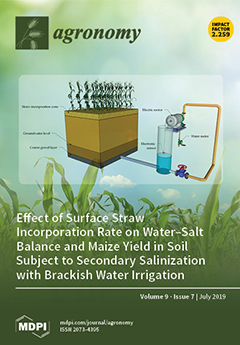Sisymbrium officinale is a wild Brassicaceae species that is known for its use in the alleviation of vocal inflammatory states. Since this species is particularly rich in bioactive compounds, there is an interest for developing cultivation protocols to use this plant as a leafy vegetable harvested at the 13th BBCH growth stage. Two wild populations of
S. officinale (L.) Scop., denominate MI (Milan) and BG (Bergamo), have been used, and three different levels of nutrients (g/m
2) have been provided such as 13 N, 7 P
2O
5, 8 K
2O (100%); 9 N, 5 P
2O
5, 5.5 K
2O (70%); and 6.5 N, 3.5 P
2O
5, 4.0 K
2O (50%). The effects of different fertilization levels were evaluated on the yield, leaf pigments (chlorophylls, carotenoids), nitrate concentration, sugars content, and on the antioxidant compounds such as anthocyanins, total phenols and glucosinolates (GLS). Plant stress monitoring was performed by measuring the chlorophyll
a fluorescence. Results indicated that yield was not affected and ranged from 0.18 to 0.47 kg/m
2, and differences were not statistically significant for chlorophylls, carotenoids, and total sugars content. Nitrate concentrations were higher in the BG wild population (4388.65 mg/kg FW) during the second cultivation cycle and lower (1947.21 mg/kg FW) in the same wild population during the first cultivation cycle, both at the 100% fertilization level. Total phenols and anthocyanins were higher in the highest fertilization rate in the MI wild population during the second cycle. The GLS were higher in the lowest fertilization rate in the BG wild population (19 µmol/g FW) grown at the fertilization level of the 50%, and significant differences were observed in the second cycle. In conclusion, the 50% fertilization level can be considered the most suitable for our experimental conditions.
Full article





